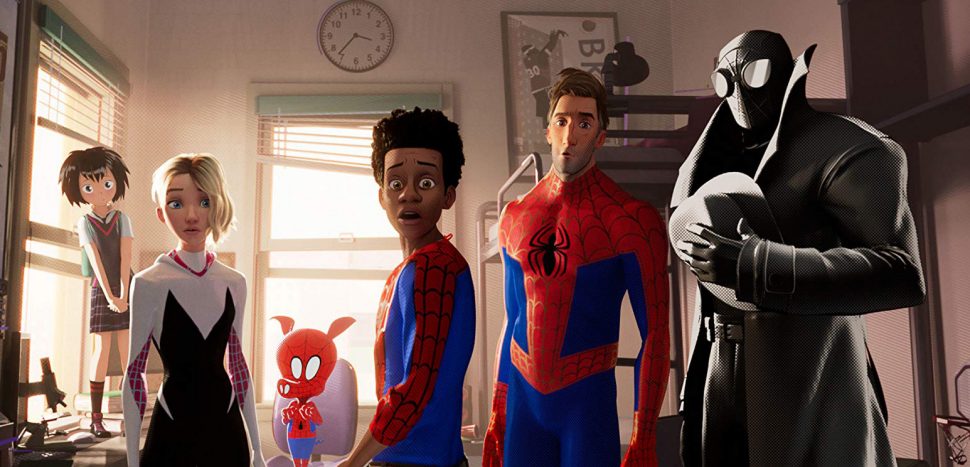 The best thing about any incarnation of Spider-Man has always been his normalcy. This is not the story of a hero who was born great but a coming-of-age tale of someone who must learn to be. Heroes born into their greatness always feel limited by their inherited qualities. It sets up an “us vs them” dynamic between those who will never have power and those who will. So, the tale of a young man trying to acclimate to the chaos of the world as well as the crisis of identity has always felt boundless for the possibilities it offers. The Sam Raimi Spider-Man films excellently explicated this. And after two subsequent live-action reboots of the story (to varying degrees of success) the recently released animated film “Spider-Man: Into the Spider-Verse” effectively achieves the heroic relatability of a hero trying to grapple with his place in the world.
The best thing about any incarnation of Spider-Man has always been his normalcy. This is not the story of a hero who was born great but a coming-of-age tale of someone who must learn to be. Heroes born into their greatness always feel limited by their inherited qualities. It sets up an “us vs them” dynamic between those who will never have power and those who will. So, the tale of a young man trying to acclimate to the chaos of the world as well as the crisis of identity has always felt boundless for the possibilities it offers. The Sam Raimi Spider-Man films excellently explicated this. And after two subsequent live-action reboots of the story (to varying degrees of success) the recently released animated film “Spider-Man: Into the Spider-Verse” effectively achieves the heroic relatability of a hero trying to grapple with his place in the world.
The last two years have been key ones for superheroes. Last year’s “Wonder Woman” was a benchmark film. This year, “Black Panther” and “Avengers: Infinity War” were record-breaking films for various reasons. And, earlier in the year we also received the long-awaited sequel to Brad Bird’s “The Incredibles.” Bird’s superheroes are original and created for the film, but in their way they offered a necessary assessment of the limits of the superhero ideology. Something that has always irked me about the superhero genre is the way they take the complex idea of who can be heroic and distil it in somewhat simplistic forms. If superheroes are special, especially those born with their skills, where does that leave human acts of kindness that cannot achieve that sort of kinetic force? It’s why Raimi’s films have always been so effective, tied more to the humanistic side of its protagonist than its superhuman side. This new film gets this immediately.
In an early scene of the film, Miles Morales, our protagonist, decked out in a store-bought Spider-Man costume, stands amidst a sea of other regular people all dressed as Spider-People. They are listening to Mary Jane Parker, the widow of the recently deceased Peter Parker. Spider-Man is dead and Mary Jane speaks to citizens of the city, telling them that they are the embodiment of the superheroic quality that Peter represented. The moment is incredibly literal in the way it vocalises an important theme but it’s a welcome emotional moment that immediately affirms where the intentions of the film’s creators lie. Everyone has power to be heroic. And this is what this Spider-Man is about. The original Spider-Man dies trying to prevent the Kingpin from wrecking this universe, trying to get back to an alternate one. Unbeknownst to this one-and-only Spider-Man, Miles Morales has recently been bitten by a radioactive spider, which also gives him superpowers.
A rupture in the universe sees Miles Morales interacting with a Peter Parker from another universe and a slew of other Spider-People from various other alternate realities out there (their appearances are one of the film’s numerous highpoints). Their appearance, of course, emphasises the idea of possibility for heroes to be anywhere. In this way, “Into the Spider-Verse” comes to divide itself between two sides. One part of the film is about Miles trying to make sense of his powers and acclimating to the different universes of Spider-People. The other film, though, is just about Miles and his life adjusting to a new school, his tense relationship with his policeman father and his burgeoning artistic sensibilities, which he shares with his Uncle, his father’s estranged brother. It’s credit to writers Phil Lord and Rodney Rothman and directors Bob Persichetti, Peter Ramsey and Rodney Rothman that both halves have their own specific momentum and complement each other in excellent ways.
One major part of this is the formal tenets of “Into the Spider-Verse,” which present it as a triumph of style. Lord and Miller’s intentions to make the film feel like stepping into a comic-book are not mere lip-service but indicate the focussed way that the film harnesses the limitless possibilities of animation to good effect. The CGI animation is made to look like hand-drawn animation in some form, and there is not a moment that something compelling is not happening in a frame. It’s not that the film never slows down; there are quiet emotional moments to enjoy, but the film’s animation is aggressively aware of its form and utilises it to such good effect, offering, perhaps, the most compelling testimony to power of animation this year (And it’s been a great year for animation, from the thriller-instinct kinetics of “The Incredibles II” to the stop-motion hilarity of “Isle of Dogs”.)
At the end of it, it’s the care with which these characters are rendered that makes the film so effective. “Into the Spider-Verse” is aware of the legacy that precedes it, and it features call-backs to all the previous versions, sometimes with humour and sometimes with emotion. But this film is its own thing. Completely. It manages to juggle the rat-a-tat-tat humour with a sturdy emotional heft. This is, after all, the first iteration of a black Spider-Man on screen. The film is aware of the value of this and Miles Morales, as an Afron-Latino Spider-Man feels especially poignant and profound, especially when measured against current cultural issues in the United States.
And so, this new Spider-Man leans into the ethos of Spider-Man and other Spider-People at their very best. It confronts the idea of reaching inside oneself and forcing something heroic of that self in the worst of circumstances. It’s a familiar heroic trope but it’s not merely incidental here but centrally established. That the film manages to accomplish this while being deft, lithe and funny is great. That it does this all while utilising animation not just as a perfunctory form but by making vivid use of its possibilities and structure by doing things and revelling in things that only animated film can do, makes it a miracle. When Miles finally reveals his new Miles-specific suit, the audience I was with cheered, I couldn’t fault them for their excitement. It was more than worth it.
“Spider-Man: Into the Spider-Verse” is currently playing at Caribbean Cinemas Guyana.








